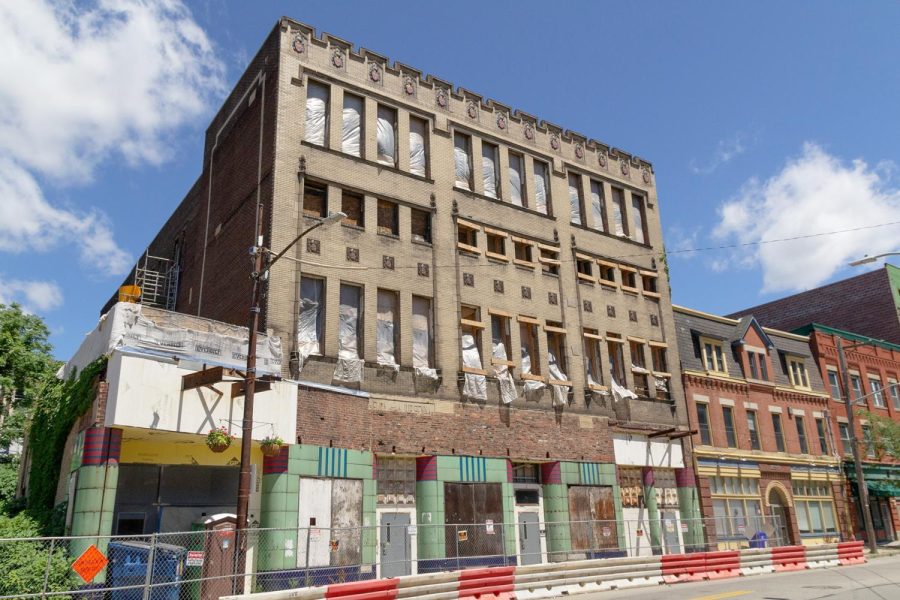Pitt expands collaboration and opportunities to Hill District with new Community Engagement Center location
The New Granada Theater, Pitt’s new CEC building, on Centre Avenue in the Hill District.
June 21, 2023
For Kelly Protho, the new director of Pitt’s Community Engagement Center, developments within the CEC in the Hill District are important to both Pitt and the neighborhoods the University impacts.
“The Hill CEC creates a space that mobilizes Pitt’s talent and resources, in partnership with the Hill community, to provide these and other opportunities directly to residents,” Protho said.
The Hill District Community Engagement Center, established in 2019, serves as a bridge for collaboration and opportunity between the University of Pittsburgh and its surrounding neighborhoods. Currently located at the Blakely Program Center, the CEC offers various programs, educational opportunities and events for Hill District residents.
This spring, the CEC welcomed Kelly Protho as its new director and announced its relocation to the Historic New Granada Theater. Protho said she is excited to partner and collaborate with Pitt staff and the Hill community and looks forward to the Center’s new space.
“The history that the theater holds within the community and Black culture is so rich, and for us to be moving into that space is amazing,” Protho said.
A groundbreaking ceremony on May 25 began construction and renovations at the New Granada Theater, where the CEC will serve as an anchor tenant along with retail, restaurant and office spaces.
Keith Caldwell, executive director of Place Based Initiatives for Neighborhood Commitments, said the new space will double the size of the old CEC and include a STEAM studio, a “key component” of the center. The 20,000 square foot facility will also house additional classrooms and offices for departments like the Center for African American Poetry and Poetics and the School of Social Work.
Marlo Hall, outreach coordinator of the CEC, said the relocation to the Theater space will help the CEC establish a “real footprint” in the Hill District community.
“This development will also increase awareness of the CEC and allow more residents to become acquainted with our work and opportunities that are provided at the CEC through our University and community partnerships,” Hall said.
The CEC is part of a long-term partnership with Pitt through the Neighborhood Commitments program, a 15 year-long commitment of “investment, infrastructure, programming, and dedicated staff,” according to Protho. She said neighborhood advisory councils, University partners and community members help the program build strong relationships with the Hill District.
“Community Engagement Centers anchor the commitment, creating a front door to Pitt right in the community and a vibrant and welcoming space for programs and collaboration,” Protho said.
Pitt Community Engagement Centers target areas and goals unique to each community within the Oakland, Hill District, Homewood and Greater Hazelwood neighborhoods. The Hill’s CEC focuses on Digital Equity and STEAM programs with emphasis on youth enrichment and workforce development, according to Caldwell.
“Our work is not just done in communities like the Hill District, but with them,” Caldwell said, “and each community’s needs are different.”
Protho said the increased focus on digital equity and STEAM programming in the CEC’s future location continues to provide shared spaces and engagement with community members.
“This type of programming is what the community has identified as important for their residents, but that may not be easy to participate in,” Protho said.
Caldwell said Neighborhood Commitments links the strength of the University with the success of communities like the Hill District. As the CEC expands its physical space to accommodate more programming and educational opportunities for the neighborhood, Pitt will use its resources, research and innovation to continue fostering a collaborative and creative community.
“Our goal is to partner with communities and help them thrive,” Caldwell said. “We understand that this work can only move as fast and as far as our ability to build trusting relationships. People connect with each other, not an institution.”








